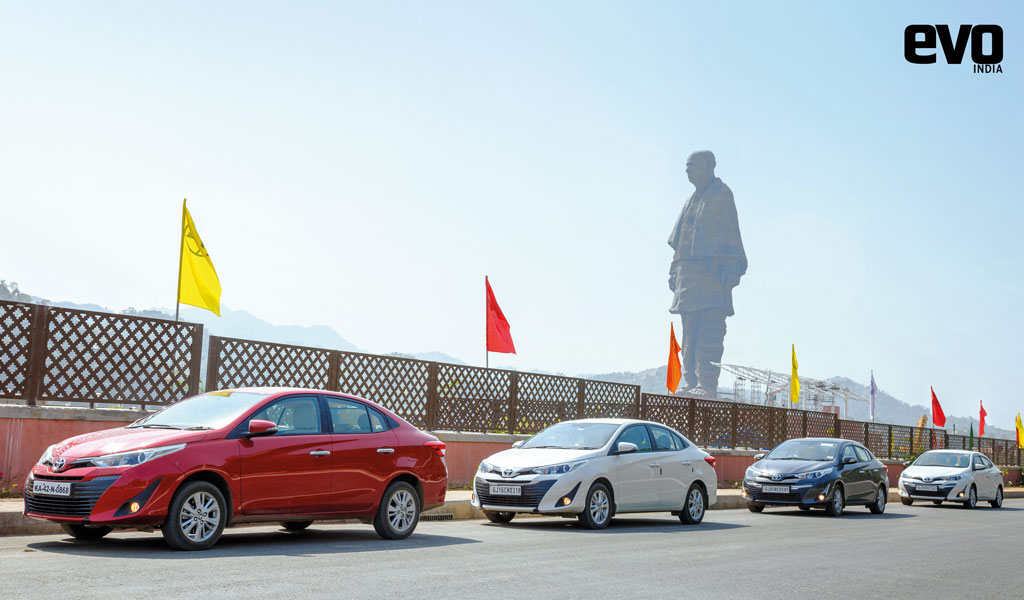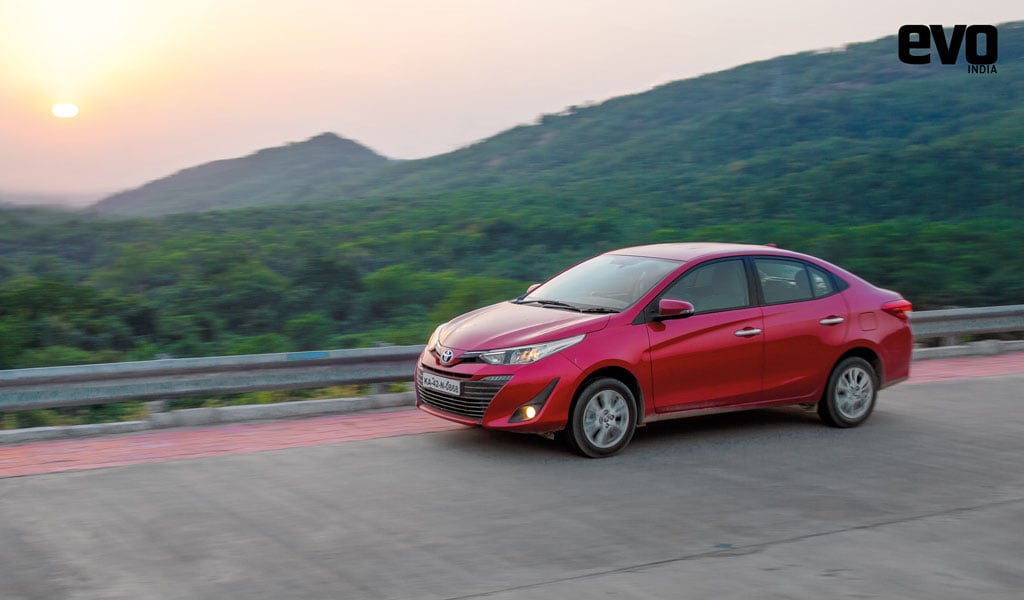Exploring the Narmada and Statue of Unity with Toyota Yaris River Drive

Rewa. Wherever we took the Toyota Yaris on the Toyota River Drive along the Narmada, the name sprung up across store fronts, sign boards and even on historical monuments that were centuries old. Driving in the Yaris and much like Toyota, driven by a better future, we also came across a certain monument that was under construction but is now the world’s largest of its kind. Inaugurated just yesterday by none other than the Prime Minister of India, the Statue of Unity pays tribute to one of the heroes of India’s freedom struggle – Sardar Vallabhbhai Patel.
The Narmada – more than just a river
No matter what you call it – Rewa, Nerbudda or Narmada – there is no denying the importance of the river and not just religiously, culturally or historically but purely for what it offers to the millions of people settled around its banks. To most of middle India, where the Narmada(Rewa) flows through, entire livelihoods are dependent on it and the people in those villages and towns refer to the Rewa as an ever present companion –a giver of life and giver of pleasure; the latter being the literal meaning of the name Narmada. Never is it just a river, which is somewhat unique to our country because neither in India nor anywhere else in the world (except ancient Egyptian culture) were rivers personified.

Starting the Parikrama of the Narmada
The brief was simple – drive the entire length of the Narmada, or do a Parikrama as most people would call it. Unlike a regular Parikrama, that is done on foot, we would enjoy the comforts of the Yaris. Though it isn’t relevant for this story, our journey with the Yaris actually began in Mumbai from where we drove up to one of the oldest settlements in India, Bharuch, all the while challenging ourselves on the fuel efficiency front. The Yaris even tells you how much money you’ve saved using a light foot, and our record was Rs.1150, which called for a celebration when we hit Bharuch (dry state, lots of Jalebis).

Bharuch is situated just a few kilometres from the mouth of the Narmada, where it meets the Gulf of Cambay or Khambhat as it is known now. Why the English name you ask? Because the port was known to traders as a gateway to the Asian mainland as far back as the second century AD. For good measure, we also drove to Dahej, to the Ro-Ro (roll on, roll off) jetty, the exact point where the Narmada meets the sea, but the jetty was non-operational and that turned out to be a damp squib.
Enroute to the Statue of Unity
No worries. Plan B was even better. Now we always try to put you, dear reader, in the driver’s seat but this time round we thought we’d take some of you with us, show you a day in the life of a road tester’s road trip. Enter Mahammadbhai Aglodiya, a Yaris owner in Bharuch, who joined us at Nanavati Toyota dealership along with his family as we set course for Rajpipla, near the Shoolpaneshwar Wildlife sanctuary, and then on to the mega (and we mean truly mega!) Statue of Unity.

This giant tribute to Sardar Vallabhbhai Patel, on a river island in the Narmada downstream from the Sardar Sarovar Dam, one of the biggest infrastructure projects to be undertaken on a river in India, has been officially inaugurated now but it was 15 days to the PM’s visit when we went there. The dam was planned soon after India’s independence and was intended to solve the problems around supply of water for agriculture in regions nearby, but persistent delays ensured that it was completed only in the early nineties and then too the problems that it was intended to solve weren’t entirely fixed.

We’re not getting into all those controversies, or the costs or whatever – our submission is that taxpayer money has already been spent so you might as well enjoy the Statue of Unity, the tallest statue in the world at 182 metres, and a truly impressive sight to behold. Along with Mahammadbhai’s family and staff from the Bharuch Toyota dealership, we soaked in the spectacular sight of the memorial, dedicated to the one of the heroes of our freedom struggle. The memorial will now draw the attention of the world towards the regions surrounding the memorial and much of Central India that has been neglected for decades.
The best of the Toyota Yaris
We also got time to talk to Mahammadbhai about his Yaris and his reasons for buying it. Safety was his first and immediate response, the 7 airbags on all variants being the factor that drew him to the Toyota fold in the first place. He also mentions the silent performance that allows the Yaris to co-exist and not disturb the tranquillity of the Narmada. The fuel efficient petrol motor goes about its job trying to protect its surroundings as much as possible. With these river drives being our attempt at preservation, we also believe that knowledge of the problem at hand is the first step towards the solution, and there could be no better ally than the Toyota Yaris.

Taking the Toyota Yaris to Barwani
We bid our friends adieu at Rajpipla and then headed off to Barwani in Madhya Pradesh. The good roads in Gujarat were a distant sight in our rear view mirror as tarmac literally crumbled to dust in MP. The Yaris was at its finest though, easily absorbing any and all bumps and preventing the harshness of the road surface from getting in to the cabin. I think this is the real highlight of the car, superb ground clearance and a solid suspension setup that neither bottoms out nor makes occupants uncomfortable or uneasy. The roads were also narrower and meandered through a number of villages. Here the manoeuvrability of the Toyota Yaris came to the fore and it was easy to tackle stray animals, people and slow moving traffic. The incredibly refined engine and the CVT made our task a lot easier and by nightfall we were in Barwani.

A megalithic (carved out of stone) statue – the tallest in the world –of the first Jain Tirthankara, Lord Rishabhadeva is just a few kilometres outside the city in a temple complex called Bawan Gaja. The statue is around 900 years old and is a very important pilgrimage site. Moving on from Bawan Gaja, we travelled to Rajghat just outside the city where young men were seen diving in to the Narmada as priests and the devout shook their heads in disapproval. They believe that the Narmada is a river that we shouldn’t dive into. Pilgrims flock to the river in droves each year hoping to cleanse themselves of their sins. But unlike the other six holy rivers in Hindu mythology, they don’t need to take a dip in the river per se. All they need to do is look at it. Legend says that the river Ganges comes to the Narmada to purify itself of all the sins of the people who have bathed in it.
In Hoshangabad during the Toyota River Drive
The next day we left for Hoshangabad. A few hours of driving later, we arrived at Maheshwar Fort. The 17 century fort has a rich history and a very close connection with the Narmada as it is literally on the banks of the river. It was the capital of the Malwa empire during the Maratha Holkar reign led till 1818 by the great Maratha queen Rajmata Ahilya Devi Holkar. Its location on the banks of the Narmada has ensured that the Fort has been flooded a number of times and there are several signs pointing to where the water level was on certain days in the distant past. The fort is also important artistically as there are a number of intricate hand-made stone carvings that are centuries old and are regarded as one of the finest examples of their kind. From Maheshwar to Hoshangabad, the roads were choc-a-bloc with people out for the Navratri festivities. The errant jaywalkers on the road were a constant hazard while driving and the services of the sharp all-wheel disc brakes of the Toyota Yaris were often called upon. A few times ABS kicked in and saved us the blushes.
An 11th century fort and much more on the Toyota River Drive
The drive to Jabalpur was a rather leisurely one and the Toyota Yaris with its peppy motor allowed us to easily keep a fairly good pace while on our way to one of the bigger towns on our route. The town had a few rather interesting sights but as luck would have it we could reach Jabalpur only around evening and we headed directly towards Madan Mahal, an 11 century fort constructed inside some huge rocks on the top of a hill. All through the drive to Jabalpur, I was at the back catching up on some sleep. The roof mounted air vents in the Toyota Yaris keep the cabin at the perfect temperature and the plush ride does you wonders on such a long drive.
TO FOLLOW US ON INSTAGRAM, CLICK HERE
The origin of the Narmada
The last day of our drive took us through some of the nicer roads of MP, through canopies of trees with the only residents being packs of monkeys, and soon we reached Amarkantak, our final destination. Amarkantak is a town like few others. It is entirely committed and devoted to one thing – the Narmada.

A number of religious places exist in Amarkantak but the most prominent among them is the Narmada Kund, the origin of the river. The place has a calm peacefulness about it that few other places as important as it have. At its centre is the small reservoir from where the Narmada flows down from the plateau and is met by a number of tributaries. Our timing couldn’t be better and we arrived at Amarkantak, on the eve of Dussehra. Narmada Kund was brimming with pilgrims and the evening aarti had a splendour and grandness to it that took our breath away. Large earthern lamps were lit up all around the kund and their glow ensured that the reflection of the Narmada temple in the waters of the small reservoir where the river originates, looked absolutely stunning.

Our journey along the Narmada culminated at Amarkantak and we successfully made our own small contribution towards conserving this incredible river. Many would wonder how. But the first step towards trying to conserve and protect the lifelines of India has to be about understanding the people, their culture, even the flora and fauna around them. Over the next few months we will take in all of India’s most important rivers, the task at hand being to bring the focus on river conservation by actually trying to understand the life of the people around these rivers. This is not just a drive along some of the biggest rivers in the country. It is an exercise driven by the dream of a better future.

You can read our blogs about the Toyota River drive here.


